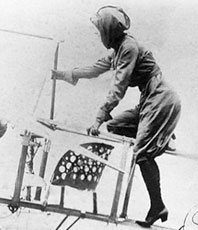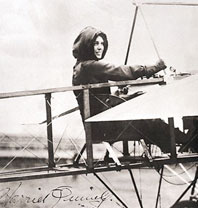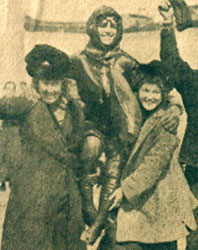|
"The trip was as easy as sitting at home in an armchair, and I never
had any doubt of my success."
—Harriet Quimby on her historic Channel flight
On August 1, 1911, at age 36, Harriet Quimby became America's first
licensed woman pilot. Less than a year later she would be dead,
victim of the kind of freakish accident that was all too common in
flying's age of innocence. In her 11 months as "America's First Lady
of the Air," as the press came to dub her, she made some dramatic
firsts, including her Channel flight, which she accomplished three
years after Louis Blériot's initial crossing. No doubt she
would have gone on to other firsts. Indeed, if death hadn't
intervened on July 1, 1912, she was scheduled within days to fly the
U.S. mail from Boston to New York, a first for a woman.
 Rise to fame
Rise to fame

Harriet Quimby was probably born in Michigan in 1875. Her father was
a farmer but not very good at it, so he moved his wife and two
daughters to California and tried his luck in other ventures, never
flourishingly. His daughter Harriet would not follow in his
faltering footsteps, becoming, long before she became a pilot, a
successful magazine writer first in San Francisco then in New York.
In 1904, at age 29, she became drama critic and editor of the
women's page for Leslie's Illustrated Weekly, a New York
magazine for which she would write for the rest of her brief career,
penning more than 300 articles for Leslie's and other
publications.
Quimby threw herself into the life of an up-and-coming reporter in
the Big Apple. She was slim, tall, vivacious, and
beautiful—one friend called her "the prettiest girl I have
ever seen. She had the most beautiful blue eyes—oh, what eyes
she had." Quimby bought herself an automobile, a sure sign of
prosperity and of her growing passion for technology and speed. She
did not join the suffragist movement then stirring up New York
society, but she was a kind of nonactivist feminist. Many of her
articles were about and for women—"Hints to Stage-Struck
Girls" and "Can Women Run Automobiles?" were but two—and
throughout her career Quimby encouraged women to follow all the
pursuits men followed, including dangerous activities like flying.
In her rise to fame, she did not forget her family; she even brought
her parents east to live in New York City.
 Smitten with the sky
Smitten with the sky

In 1910, Leslie's devoted an entire issue to aviation. Quimby
was so inspired that she attended an international air meet at New
York's Belmont Park and, by the spring of 1911, was enrolled in a
nascent flight school on Long Island. Her teacher had been a student
of Louis Blériot's, and under his tutelage Quimby excelled.
She had both a natural talent for flying and the drive to prove that
women could advance in the field as well as men. "I'm going in for
everything in aviation that men have done: altitude, speed,
endurance, and the rest," she declared. At the same time she
remained distinctly feminine, going aloft in a one-piece,
plum-colored satin flying suit and describing details and sensations
that no male flyer would have been caught dead describing. "You
don't know what a fine thing for the complexion a dew bath is," she
once wrote, telling of the pure, moist air at altitude.
Quimby quickly became a celebrity aviatrix, or woman aviator. It was
a lucrative sideline. In September 1911, she earned $1,500 at an air
meet, during which she became the first woman to fly at night. Two
months later she flew at the inauguration festivities for Mexico's
president-elect, also earning a tidy sum. During one flight there,
her engine quit in midair, but she kept her cool and glided to a
safe landing. Her calmness drew in part from careful preparation.
"Only a cautious person, man or woman, should fly," she wrote. "I
never mount my machine until every wire and screw has been tested."
But it also came from a desire to push the envelope, which many
early aviation pioneers possessed.
 A plan is hatched
A plan is hatched

It was while in Mexico that Quimby came up with the idea of
attempting the Channel crossing. She told only a few people of her
plans, believing that if word leaked out, another woman might beat
her to it. In March 1912, she sailed for Europe with a letter of
introduction to Louis Blériot. She hoped to purchase a new
70-horsepower Blériot XI for the crossing and then bring it
back to America with her. When they met, Blériot told her
that that model was not yet ready, so Quimby convinced him to loan
her a 50-hp Blériot XI for the attempt while her 70-hp plane
was being built.

Quimby began to think the worst—she might have to ditch the
plane in the Channel.

She then traveled with Blériot to the village of Hardelot on
the French coast, where he had a hangar. She wished to make some
test flights, but the weather remained ugly for days. Fearing she
would miss her Channel opportunity, Quimby secretly shipped the
plane to Dover, England—she wanted to fly from England to
France, rather than the other way around as Blériot had done,
because she felt the cliffs at Dover were dauntingly higher.
 Will of steel
Will of steel

The morning of her flight, April 16, 1912, dawned foggy, with wind
sure to come up. The dicey weather was just one of many reasons a
less determined person might have reconsidered the flight. The
Blériot XI was by all accounts the trickiest plane
Blériot had yet designed, and Quimby had never piloted the
model, much less the particular plane Blériot had loaned her.
She had never flown long-distance over water and had never used a
compass, which Gustav Hamel, a British pilot who was at her side
that morning, had just taught her to use and insisted she bring with
her. Several flyers had lost their lives trying to make the
crossing, and Hamel reminded her that if she flew just five miles
off course, she could disappear in the frigid Channel, never to
return (he himself later did just that).
Hamel even offered to don Quimby's satin suit and fly in her stead,
secretly switching places with her after landing in France. But such
an offer touched a nerve in Quimby, as did the suspicion about her
resolution that she sensed in the crowd gathered on the white cliffs
that morning. "I was annoyed from the start by the attitude of doubt
on the part of the spectators that I would never really make the
flight," she later wrote. "They knew I had never used the machine
before and probably thought I would find some excuse at the last
moment to back out of the flight. This attitude made me more
determined than ever to succeed." She did permit Hamel to take the
plane on a test flight, and she accepted a hot water bottle that
someone thrust into her hands.
 History in the air
History in the air

At 5:30 a.m., she took off. The sky overhead was clear, but the
French coast, which two days before had been clearly visible 22
miles away across the Channel, was now completely obscured by a fog
bank. Quimby circled up to 1,500 feet, flew straight over Dover
Castle, and made a beeline towards France. "The fog quickly
surrounded me, like a cold, wet, gray blanket," she later wrote. To
try to clear it, she ascended to 6,000 feet, where the mist, she
remembered, "felt like tiny needles on my skin." The hot water
bottle did little to warm her up, and her head began to ache from
the strain of concentrating on the compass to keep her course.
After flying for the better part of an hour in deep fog, she decided
she had better descend and look for an opening in the mist. As she
lowered the nose in descent, gasoline flooded the engine, which
began backfiring. It was a design flaw that had already cost several
flyers their lives. Quimby began to think the worst—she might
have to ditch the plane in the Channel. "To my great relief," she
wrote later, "the gasoline quickly burned away and my engine began
an even purr."
She looked at her watch—her only other instrument besides the
compass—and determined she must be close to her destination.
Sure enough, the Blériot XI soon broke free of the cloud bank
and there below lay a white-sand beach and, beyond it, green
farmland—France. Not wishing to tear up the nicely tilled
fields, she landed on the beach. Her flight had lasted one hour and
nine minutes.
For a minute she found herself utterly alone amidst the enormous
silence that followed the shutting down of her engine. But then she
was surrounded by excited fishermen and their wives and children,
all carrying pails of sandworms. It turns out she was only two miles
from Hardelot, where Blériot housed the plane she had just
flown, and these people had immediately realized what she'd
achieved.
By a strange twist of fate, no banner headlines followed Quimby's
historic feat, because just two days before the "unsinkable" Titanic
had gone down in the North Atlantic, with more than 1,500 lives
lost. Quimby's achievement was all but overshadowed. Nor did she
receive much fanfare in New York upon her return to America in May.
Just two weeks before, over 20,000 suffragists had marched up Fifth
Avenue, and New York's mostly male leadership was still reeling from
the event.
 Tragedy in the sky
Tragedy in the sky

But fame came to her nonetheless, and Quimby hardly had time to
worry anyway. Her new 70-hp Blériot XI had arrived from
Europe, and she saw the white monoplane, along with her new-found
stardom, as her ticket to financial independence. Indeed, her
manager had lined up a seven-day event for which the "Queen of the
Channel Crossing," as she was now billed, would be paid the
astronomical amount of $100,000. It was the Boston Air Meet, held on
a peninsula southeast of the city, and it was on the last day of the
meet—her first public appearance since the crossing—that
she was to fly the mail to New York.
That flight never occurred. One late afternoon, Quimby took the
manager of the meet, one William Willard, up in her two-seat plane
for a run out over Dorchester Bay. Moments before the flight, she
had laughingly assured reporters clustered around her that a forced
landing in the bay was not part of her plans. "I have no intention
of coming down in the water," she said. "I'm a cat, and I don't like
the water." Quimby was never above tempting fate, and this time it
arguably worked against her.

“Flying is a fine, dignified sport for women, it is healthy
and stimulates the mind.”

As the pair returned from circling the Boston Light far out in the
bay, the sky had turned a dazzling orange. Five thousand spectators
watched as the monoplane approached over the tidal flats, strikingly
silhouetted against the blazing sky. Without any warning, the
plane's tail suddenly rose sharply, and Willard was pitched from the
plane. The two-passenger Blériot was known for having balance
problems, and without Willard in the rear seat, the plane became
gravely destabilized.
For a moment it seemed that Quimby was regaining control of the
plane. But then it canted forward sharply again, and this time
Quimby herself was thrown out. The crowd watched in horror as the
two plunged a thousand feet to their deaths in the harbor.
Ironically, the plane righted itself and landed in the shallow water
with minimal damage.
Quimby was 37 years old.
 Postscript
Postscript

An explanation of what likely happened appeared the following August
in
Aircraft magazine. The Blériot XI featured a
horizontal tail wing that was meant to help offer longitudinal
stability to the two-passenger plane. But when the aircraft nosed
down beyond a certain angle, the tail surface could provide unwanted
lift that increased with plane speed until a critical moment was
reached. At that point, wrote the article's author, "it is
impossible to get the tail down though the elevator stick is pulled
back. The faster the machine dives, the more lift the tail provides
until it has the plane in a vertical position, hurling the pilot and
passenger out (unless they are strapped in)."
Quimby and Willard, alas, were not strapped in. Seat-belt use was a
thing of the future—only a few European pilots had begun to
wear them.
Before she had traveled to Boston, Quimby had left a sealed note for
her parents in New York. If bad luck should befall her, she wrote,
she wanted them to know that she would meet her fate "rejoicing."
Quimby died doing what she loved, and in her demonstrative but ever
feminine way, she was one of aviation's true pioneers.
Perhaps her greatest contribution was to give courage to women who
wished to take to the air. "Men flyers have given the impression
that aeroplaning is very perilous work, something an ordinary mortal
should not dream of attempting," she once wrote, "but when I saw how
easy men flyers handle their machines, I said I could fly. Flying is
a fine, dignified sport for women, it is healthy and stimulates the
mind."


|


|
Ready to fly: Harriet Quimby in her Blériot XI
monoplane, 1912.

|
|

|
Dressed to the nines in high heels and satin suit,
Quimby climbs into her Moisant monoplane, the model she
learned to fly on.

|
|

|
A picture of femininity and fearlessness: Quimby
cranking the propeller.

|
|

|
Quimby, in this autographed photo, sits in the plane she
flew across the English Channel.

|
|

|
In this shot photographed from a newspaper, Quimby is
lifted aloft just after landing in France on April 16,
1912.

|
|

|
A group of men, including Quimby's flight instructor
(right), examine her downed monoplane following her
tragic accident. The plane had flipped over onto its
back after landing in Dorchester Bay.

|
|
|

